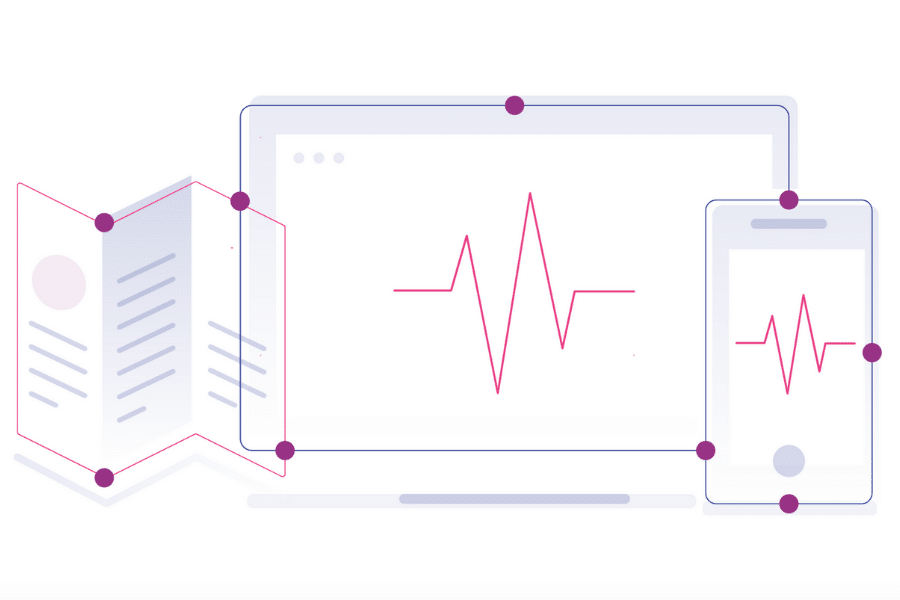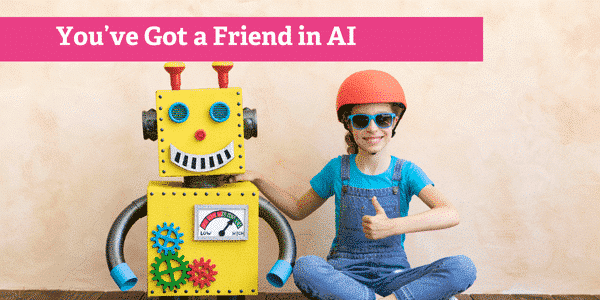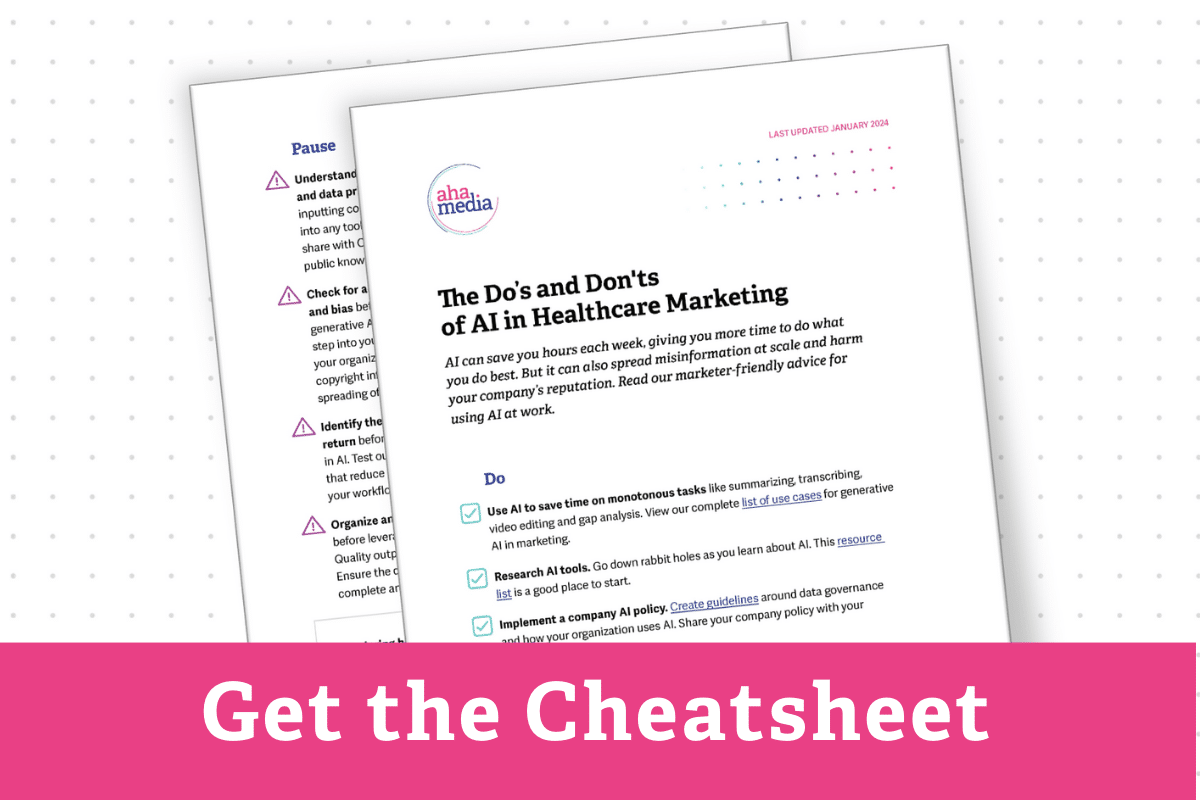Resource Hub
The Ultimate Guide to AI for Healthcare Marketers
The Do’s, Don’ts and What You Should Know

AI Is Changing Marketing
Artificial intelligence (AI) is exciting. It has great potential to save marketing teams time and resources and improve how we serve readers and patients.
But these perks have risks. Using AI incorrectly could result in spreading misinformation, compromising data security or jeopardizing your company’s reputation. Your responsibility as an ethical healthcare marketer is to do your due diligence before going all in on AI. We’re here to help.
Feeling the Pressure to Adapt?
By the end of 2023, 98% of marketers were using AI at work. This statistic testifies to the limitless opportunity we all see in AI — and the pressure to unlock it. We’re faced with the challenge of adapting or falling behind.
This resource hub is a source of truth and collection of insights about AI for the healthcare marketing community. Learn the ins and outs of using AI in healthcare marketing — including the risks, limitations, best use cases and how to protect your readers and yourself.
Strapped for time?
Get a quick rundown of the do’s and don’ts of AI in healthcare marketing.
How to Use AI in Healthcare Marketing
AI is a lifesaver for the right tasks but isn’t fit for every job. Use AI to help with the right things so you can devote more time and energy to those tasks better suited for humans.
Marketing tasks to outsource to AI
Why should marketers use AI? It can help automate or speed up tasks that take significant time to execute but little time to validate.
Tools like ChatGPT are perfect for tedious work or repetitive jobs that can be done at scale. Here are some examples:
Research tasks:
- Keyword and keyphrase research
- Building preliminary audience personas
Basic content generation tasks:
- Repurposing content into new pieces, like social posts
- Idea generation and finding connections between ideas
- Writing metadata, headlines and subject lines
- Outlining or creating content briefs
- Creating basic graphics
Organization tasks:
- Summarizing meeting notes or action items
- Summarizing bodies of texts
- Data organization or formatting
- Transcribing videos and stakeholder interviews
- Automating reporting
Review tasks:
- Grammar and spelling edits
- Checking reading level and sentence structure
- Quick video editing
- Analyzing and providing feedback on your work
Two additional use cases we’re excited about at Aha Media are using AI to:
- Improve your healthcare website
- Perform content gap analysis
You can customize the user experience on your website using healthcare chatbots, personalized content suggestions and even customized design elements. But AI isn’t only useful for tailoring UX; certain tools can streamline and improve the experience in general. Read more from Chris Penn:

AI can improve access to information on your website that’s hard to find. For example, you may have a page on sciatica, but someone who doesn’t know they have sciatica may search for “back pain.” Traditional on-site search won’t help them because they aren’t using the right terms.
But a language model can translate consumers’ natural language into the correct search terms, digest the page content and return it back as a conversation. We can use these models to “broker” consumer interactions with our data and improve the customer experience.
Chris Penn
Co-Founder of Trust Insights, Inc.
You can also use AI to identify what’s missing in a piece of content based on your audience’s needs. Andy Crestodina describes how to leverage AI for persona-driven gap analysis (quote pulled from this webinar sponsored by Content at Scale).

Conversion is a lot about getting people’s questions answered. But it’s hard for a human brain to look at something and identify what’s missing or find content gaps, like objections you didn’t address or questions you failed to answer.
Give the AI a detailed persona, then copy and paste your content and ask, “To what extent does this page meet or not meet this visitor’s information needs?” When properly trained, AI can give you exactly what’s not on the page — the important things you missed.
Andy Crestodina
Co-Founder and CMO of Orbit Media
How NOT to use AI
Wise men say, “Only fools rush in.” Racing to make the most of AI could lead to outsourcing the wrong tasks.
Here are some marketing tasks that AI is not suitable for:
- Fact-checking information: OpenAI itself tells us, “ChatGPT can make mistakes. Consider checking important information.” Information from AI tools must be fact-checked by a human — never by the model(s) themselves.
- Creative or strategic work: AI cannot compete with human expertise when it comes to building a marketing plan or creating reader-facing materials from scratch. Use AI to save time and resources on monotonous tasks so you can put that time and human capital toward work that requires a human touch.
- Creating “original” content: AI is good at producing surface-level content that summarizes other sources. But Search Generative Experience (SGE) is changing search, eliminating the need for this kind of content. Limit AI content creation to repurposing your content. For example, ask ChatGPT to spin a human-written blog post into a social post (and run it by a human editor before publishing, of course).
Read why Ann Handley advises against using AI as a writing tool.

Clear writing is not the same as genuine insight. Generative AI is more of an efficiency accelerator than a “writing” tool.
I rarely use AI for anything reader-facing because trust is paramount in marketing. (Especially in healthcare.)
Ann Handley
Chief Content Officer at MarketingProfs
Learn more about the drawbacks of using AI writers in healthcare marketing.
How to Create Effective Prompts
Quality prompts elicit quality responses. Your prompt engineering skills directly impact the quality of the output you get from AI.
6 prompting best practices for marketers
Learn the basics of prompting AI for healthcare marketing.
1. Deliver clear instructions
When prompting an AI tool, tell it exactly what you need, including an appropriate format for its response. (How many words or paragraphs? Do you want bullet points?) The more details you include, the more relevant your output will be.
2. Give it a role
Tell the AI who it is, what it does, what it’s an expert in and/or what it should know. Use keywords related to the role that will help the AI understand its subject domain.
3. Provide reference text
Include a link to a webpage or PDF that explains what the AI needs to achieve its goal. For example, if you’re prompting it to use plain language in its response, train it with materials that describe how to use clear language in marketing materials. If you want it to include expert insights, paste in a transcript of a stakeholder interview to reference.
4. Split up complex tasks
Tools like ChatGPT are known to “miss” steps in the work process. Break down a complex task by delivering clear, step-by-step instructions, one at a time.
5. Give processing time
It’s common for an AI tool to answer a question preemptively. Instruct it to work out the correct solution before providing an answer. It may take a little longer to receive a response, but that’s a good thing. It means it’s working.
Ruben Hassid shares a sample ChatGPT prompt for writing LinkedIn hooks. This prompt gives ChatGPT a role (social media expert), includes clear instructions, provides reference text describing a good hook and instructs it to go step by step.
6. Develop a prompt library
It takes time to find prompts that work. Create a “library” of effective prompts and share it with your team to save everyone time.
Pro tip: ChatGPT Team offers a secure, collaborative workspace where you and your team can share chats and custom GPTs.
How to improve poor output
AI uses math, not magic. It’s going to make mistakes. Don’t give up on it when it does — consider it feedback to refine your part of the process.
What should you do when AI gets it wrong?
- Rework your prompt. You may need to split up instructions into simpler steps and explicitly tell it to go one at a time. Or you may need to include more context, more specific details or an example of what you’re looking for.
- Remind it to take its time. ChatGPT’s “instinct” is to use the data available to predict the right response immediately — not to examine the steps required to determine the answer. It’s like working with a third grader: You may need to tell it to go in order and work out the solution first.
- Tell it to check its work. Simply asking ChatGPT, “Did you miss anything?” can prompt it to check over its work and ensure it completed every necessary step.
- Review your data. Predictive analysis only works with high-quality data. If you’re feeding a dataset into an AI tool, make sure it’s complete, accurate, relevant and unbiased.
Learn more about AI’s ability to write using plain language in our Case Study: Can AI Write Web Content in Plain Language?
Risks of AI in Healthcare Marketing
While AI has the potential to do a lot of good for the healthcare field and its consumers, it could just as easily cause harm.
Learn more about human-written vs. AI-generated healthcare content.
What are the ethical concerns with ChatGPT in healthcare?
AI writing tools make it easier than ever to spread mass amounts of misinformation. Platforms like ChatGPT and Google’s Bard are not void of bias and run the risk of perpetuating medical racism. Human editors must check generative AI content for bias.
It’s also crucial to check generative AI text for accuracy, especially in healthcare. As OpenAI states, “ChatGPT sometimes writes plausible-sounding but incorrect or nonsensical answers.” Inaccuracies in medical writing can cause harm at scale for readers by giving them the wrong information, providing dangerous medical advice and making it harder to find quality healthcare information they can trust.
AI misuse can put your organization at risk as well. Publishing generative AI content comes with potential legal and data privacy risks. If you aren’t careful, you could inadvertently infringe on copyright by publishing plagiarized information.
And remember that anything shared with OpenAI becomes public knowledge. Without taking proper precautions, it’s possible to compromise secure company data, including protected health information (PHI).
Want a more comprehensive view of the risks of AI for medical writing? Watch key parts of a panel discussion about AI in healthcare communications, sponsored by Aha Media Group.
How to invest in the right tools
It’s easy to become consumed by the world of AI and all its promises. “Shiny object syndrome” could result in overinvesting money and time into tools that don’t provide a sufficient return.
Before investing considerably in AI, try a variety of tools and focus on the ones that can help you reduce expenses or streamline your workflow. Don’t let something you don’t need cost you any time or money. Read more advice on investing in AI from Jen Jenkins.

Find actual problem points that AI can assist you with and experiment with those. For example, I need resources to make edits and answer client questions rather than generate text or imagery.
Stay involved with the conversation by continuing experimentation and research. This is the only way content creators can retain credibility in a current zeitgeist that prioritizes AI as the answer to our “problems” without any actual root cause analysis.
Jen Jenkins
Associate Director, Digital Experience at University of Utah Health
Generative AI Policies
While 98% of marketers currently use AI at work, only 22% of organizations have policies surrounding employee usage of generative AI. This leaves room for great risk.
Why is having a company AI policy important?
This precaution helps reduce potential legal and data privacy risks (such as copyright infringement or compromising PHI).
In addition, AI output is only as strong as the data input. Data governance guidelines ensure you’re inputting accurate and organized data to get the best results.
What to include in an AI policy
Your AI policy should include guidance around how your organization uses AI and user data. Consider these areas:
- Data governance: How is user data being used? Is it input into OpenAI platforms? Who receives access to the data? How is it stored, and for how long?
- Internal data practices: What are your internal procedures relating to data? How is data collected, organized and “cleaned” to be AI-ready?
- Generative AI usage: Is your company using AI to create full pieces of text? To edit text? To create short elements of content, like headlines or subject lines? To generate images? For idea generation?
- Editing practices: Is a human editor fact-checking and editing content so readers can trust that it’s accurate?
Check out Aha Media Group’s AI Policy as an example.
How to use a company AI policy
Share your policy internally for employee compliance and externally for transparency with your audience. Ensure your team understands the importance of following the guidelines and the risk of taking shortcuts like publishing generative AI content without adequate editing.
Additional Resources for Healthcare Marketers
Looking to learn more about how to improve your processes with AI? Explore some of our team’s favorite guides, courses and helpful resources:
- Neuron’s Top AI Tools list: Keep up with this constantly updated roundup of popular tools for a range of use cases (with honest reviews).
- OpenAI’s Prompt Engineering Guide: Explore strategies for getting better results from ChatGPT, straight from the source — OpenAI.
- OpenAI Cookbook’s Related Resources article: The Cookbook is better suited for users looking to build a custom GPT with OpenAI, but this specific article is a helpful collection of prompting libraries, guides, courses and papers.
- Piloting AI: Paul Roetzer’s marketing-focused AI course has step-by-step lessons for marketers at every level, from entry to CMO. Recommended by our Founder and President, Ahava Leibtag.
- Beginner-level LinkedIn Learning prompt engineering courses: Talking to the AIs and Joining the NLP Revolution are highly rated intros to prompt engineering, free with a subscription to LinkedIn Learning.
- How to Create AI Marketing Personas: Andy Crestodina from Orbit Media shares how to make AI marketing personas using ChatGPT and Bing.

You’ve Got a Friend in AI: A Human-Centric Approach to Healthcare Marketing
Have you heard the buzz? Artificial intelligence (AI) is the new shiny toy in healthcare marketing. It promises to revolutionize how we reach and engage with patients, analyze data, and optimize campaigns. All the bells and whistles. To infinity and beyond! Maybe...

Strategic Guide to Repurposing Healthcare Content for Social Media (Minimize Your Workload, Maximize Results)
Think about how many people on your team are responsible for executing your social media strategy. Multiply that by 40 hours a week and 48 weeks a year (you are taking vacations, we hope). Raise your hand if it never feels like enough people or time to pull off the...

How to Choose the Right Keywords & Get Better SEO Results
The worst part of SEO content planning? Typing a phrase into Semrush for keyword ideas and seeing, “View all 31,954 keywords.” That’s what a Keyword Overview search for “bariatric surgery” will give you. (Want a real challenge? Try “cancer treatment.”) You can target...

